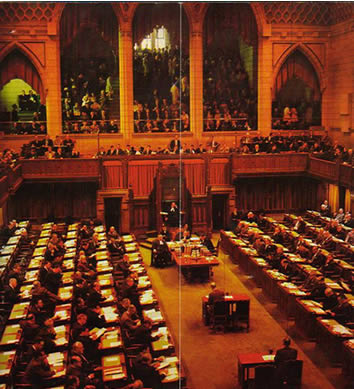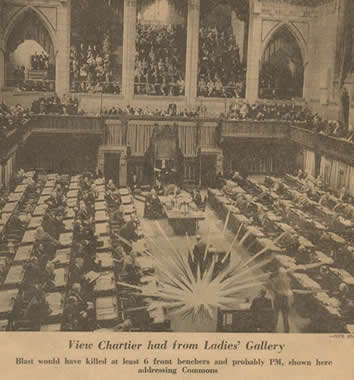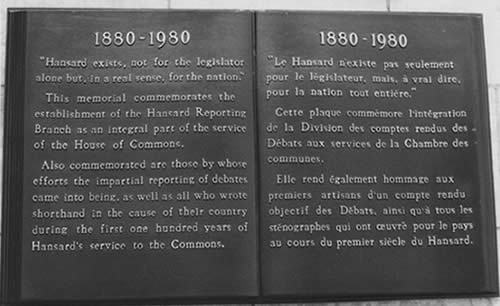
|
|
In Memory's Eye Recollections of Canadian Parliamentarians The Senate is the second constituent element of the Parliament of Canada. Its membership is non-elected, having been selected and nominated by the Prime Minister of the day. As such it is a total negation of democracy, devoid of franchised legitimacy, and demeaning to Canada. It is a festering sore on the body politic. No Prime Minister has ever been willing to lance it. It has never figured as the central issue in any Canadian election. Canadians have never had a chance to express their opinion of it in a referendum. Do Canadians want only one man to continue to have the unfettered power to appoint persons to the Senate? To ask is to answer. There are three constituent parts of Parliament. Everyone knows the first two, Commons and Senate, but time after time aspiring candidates for jobs on Hansard failed to name the third, which is the Monarch, pro tem. In the case of the eight Prime Ministers who held office during my service with the House of Commons the monarch was one solitary figure, Queen Elizabeth II, whose accession to the Throne took place in 1952 and which Throne she has occupied ever since. One of her duties whenever she is in Canada, and during her visit Parliament is called into session, is to read the Speech from the Throne. This she does in the Chamber of the Senate in front of assembled Honourable Senators, robed Justices of the Supreme Court, Ambassadors of foreign countries, and an assorted motley of common Members of Parliament. This she does, speaking both official languages. This she does with practice and ease. When she is not in Canada, a Speech from the Throne is normally read by the Governor General pro tem. Elizabeth II in the course of her long life has seen Prime Ministers, members of the Judiciary, many, many Ambassadors, and thousands of elected Members of Parliament and appointed Senators come and go, however long tenured they may have enjoyed elected or appointed office. Throne Speeches are well circulated in advance, obviating the need for Commons Hansard reporters to be present. Our presence was rightly restricted to that of observers. One memorable occasion was her entry into the Commons foyer, regally gowned, tiara firmly in place, to attend a dinner hosted by then Prime Minister Pierre Trudeau. For a moment I came to understand the passion, the curiosity, the patience of those countless thousands of her subjects who lined the streets in Ottawa and other Canadian centres hoping for a momentary glimpse of the Queen and, if lucky, became the recipients of a smile or trademark hand wave. In her person she manifested a royal presence. The question of what is to become of the Monarchy in the ongoing story of Canada may soon come to a head. Soon is a relative term, but the question will demand an answer. That answer can be most democratically answered in a referendum. What is there to fear in asking Canadians what they wish? The Queen is a decent person. Will she be followed by a jackinape, a common pot walloper, a Defender of the Faith, or a worthy Canadian Head of State chosen by the free will and free votes of citizens who themselves, or their children, can aspire to that position by virtue of competence and integrity, and not by happenstance of birth? Again to ask is to answer. The history of Hansard as a parliamentary institution was the subject of an exhibition held in the House of Commons in April 1980. "In Memory's Eye" contains numerous references to interaction between Members of Parliament and the people who staffed Hansard in the Canadian House of Commons during the thirty-five years that its author worked there between 1960 and 1994. Hansard reporters during that time were vital cogs in the machinery of Parliament. Highly skilled shorthand writers and stenotype operators, they devoted their talents to capturing the spoken words of politicians in all parties representing all regions of Canada, in debates the outcome of which was the formulation of the laws of the land. They took their work seriously. Some careers spanned over forty years. Seated at desks in the centre of the Chamber of the House of Commons they became part of the furniture, a fixture seen but not noticed by those they served. They became familiar with the speaking styles, nuances, cadences, favourite expressions of those Members who participated frequently in the proceedings, and when required made them conform to necessary grammatical changes. There were two branches, English and French, staffed by specialists in their own language. The English reporters and editors on staff at the time of the centennial celebration in 1980 were Jack Dyer, Ita Straszak, Doug Baker, Brenda Morrison, Peter Parsons, Charles Fisher, Ron Tremaine, Brian Potvin, James McCrae, Les Lusk, Una Allen, John Ward. As attrition took place, a new generation of stenotype-machine shorthand reporters, capable of providing closed captioning to the televised proceedings of the House, joined the staff. They included Ron Curry, Diane Halvorsen, Lillian Purdy, Nancy Campbell, Bruce Hubbard, Joan Henderson and John Waddell. Regrettably their careers as Hansard reporters were abruptly terminated when tape recording replaced them. Fortunately all the people of Hansard are honoured by a memorial plaque which hangs in the foyer of the House of Commons. Finally, one of the photographs below shows the House of Commons in session in 1964, when Pearson was Prime Minister and Diefenbaker was Leader of the Opposition. Halfway between them sits the Hansard reporter who just happens to be the author of "In Memory's Eye" forty years later.  Historic Photographs The first is reproduced, with grateful acknowledgement, from the Ottawa Citizen, showing how an explosive device thrown into the Commons Chamber in 1966 bombing incident could have wreaked havoc.  The second shows the Hansard centennial plaque which hangs in the foyer of the Parliament Buildings. 
Home | About | Canadian Vindicator | Literature | Gallery | History
|
|||||||||||||||||||||||||||||||||||||||||||||||||||||||||||||||||||||||||||||||||||||||||||||||||||||||||||||||||||||